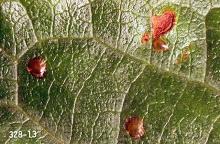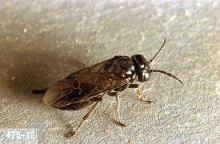Caliroa cerasi
Pest description and crop damage Pear sawfly is a European insect now found in most areas of the U.S. It attacks both pear and cherry, and also is found on mountain ash, hawthorn, and ornamental Prunus spp. The adult is a glossy black wasp about 0.2 inch in length. The larva initially resembles a small slug, due to the olive-green slime that covers the body and the fact that the head is wider than the rest of the body. Mature larvae are 0.37 inch in length and orange-yellow. Larvae feed on the upper surface of leaves, skeletonizing them, the fruit surface may also be scarred when populations are very high. Heavy feeding causes leaf drop with reduction in vigor, yield and return bloom, particularly on young trees.
Biology and life history Pear sawfly overwinters as a pupa in a cocoon two to three inches deep in the soil. Adults emerge over an extended period in late April to May. The adult female inserts eggs into leaf tissue, and eggs hatch in ten to fifteen days. Larvae immediately begin to feed on the upper surface of the leaf. After three to four weeks, they drop to the soil to pupate. Second generation adults emerge in July, and larvae from this generation feed in August and September. Most larvae from this generation drop to the ground to overwinter.
Pest monitoring Watch trees for the slug-like larvae especially in August and September when large populations can build up.
Management-cultural control
Home orchardists: Individual larvae can be picked off, or they can be washed off with a strong stream of water.
Management-chemical control: HOME USE
- insecticidal soap-Some formulations OMRI-listed for organic use.
- kaolin-Applied as a spray to leaves, stems, and fruit, it acts as a repellant to some insect pests. Some formulations are OMRI-listed for organic use.
- pyrethrins-Highly toxic to bees. Some formulations are OMRI-listed for organic use.
- spinosad-Some formulations are OMRI-listed for organic use.
Management-chemical control: COMMERCIAL USE
Usually controlled by regular spray programs but high populations can occur, particularly in organic pear orchards. Application of spinosad (some formulations are OMRI-listed for organic use) has been found to provide control.
- kaolin (Surround WP) at 50 lb/A. REI 4 hr. PHI 0 days. Thorough coverage is important. OMRI-listed for organic use.




